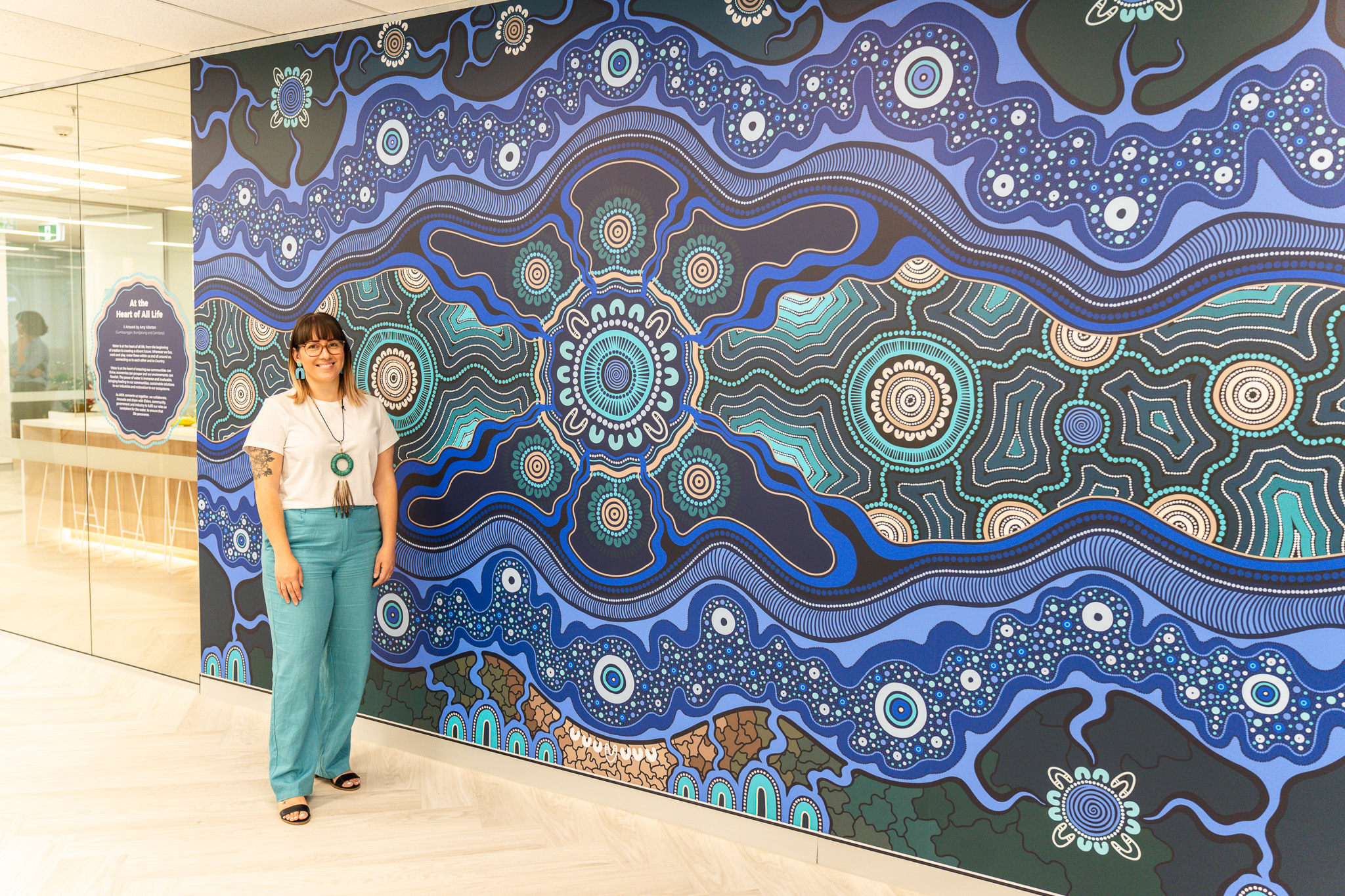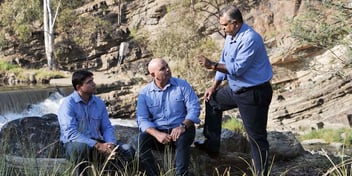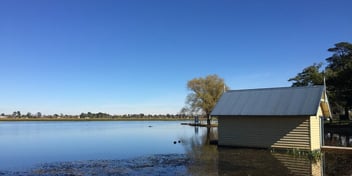How Indigenous-led business is shaping the water community

In October 2023, the Australian Water Association launched its inaugural Reconciliation Action Plan (RAP). The RAP cover art – At the Heart of All Life – was created by Gumbaynggirr Bundjalung woman Amy Allerton, and represents everyone and everything being connected by water, as well as the Association’s key role as a connector for community and stakeholders, members, government and industry.
Founder and Director of Indigico Creative, Allerton is a contemporary Aboriginal artist who's been providing graphic design services around Australia since 2014, collaborating with businesses and partnering with communities to creatively communicate their stories.
“Working on RAP artworks with organisations, agencies and not-for-profits is my favourite thing to do. It's a really personal and important collaboration. Being able to play a role in this path is not insignificant. I take it very seriously and it's a privilege to collaborate on that journey,” she said.
Allerton’s process and artwork is driven by her personal and professional vision that every story is given a voice – to revitalise communities, reconnect to culture and restore identities to build a stronger future.
“You can’t downplay the significance of interweaving cultural storytelling with business. Story connects hearts and minds through shared experiences and emotions. Listening to people's stories: it’s a really key part of achieving reconciliation,” Allerton said.
“We believe that stories are what bring us together. Every individual, every business and every community has a story that deserves to be told. When I get to work as an Indigenous business with other organisations and agencies, it's all about harnessing the purpose, power and perspective of First Nations storytelling – it has a place in everything and for everyone.”
Allerton said working alongside non-Indigenous businesses is hugely impactful, not just for the company or agency, but for the people interacting with them, directly or indirectly.
“Story can change the world. We are sharing together, building respect and connection, giving more space to our beautiful First Nations history and showcasing our incredible capacity, creativity and innovation,” she said.
“As First Nations people, we can’t achieve that connection with the broader community on our own. We are only 3% of the population – it has to be a united goal and one we all work together to achieve. And I see working alongside non-Indigenous businesses as key to that.”
On Country
For many Indigenous-led businesses, the water sector provides an opportunity to work on and care for Country, but also to boost local communities through training and employment opportunities.
Established in 2021, Wara Paring Civil is a 100% Indigenous-owned construction contractor supported by Melbourne Water and Aqua Metro Services, a partnership that inspired the organisation’s name – Wara Paring means ‘come walk the path together’. Wara Paring Director Dan Charles said land and water is central to Aboriginal culture and identity, so the potential to help maintain and preserve water is one of the reasons why a lot of Indigenous people are drawn to the sector.
“To care for, and to help preserve something that has meant so much to our people for so long – it's a food source, a way of living, a way of life – to have the opportunity to work with that is what we enjoy,” he said.
“We had a job a couple of years ago at Dights Falls on the Yarra. David George, a fellow director of Wara Paring, is a Wurundjeri man, so he was able to talk to the others about the cultural significance of his Country, and how it was where the freshwater meets the saltwater, and the different food sources.
“Getting the chance to work on those types of jobs, that’s what draws people in and keeps them looking forward to the next one.
Valuing community
While Charles acknowledges that the job is not all waterways and wildlife, the water sector presents an abundance of opportunities for Indigenous businesses and communities.
Birubi Australia Managing Director Farin Wanganeen and Construction Manager Markus Dunatov are hoping that the hydrogen project coming to South Australia will be one of those opportunities where Indigenous businesses are able to further shape water-related projects.
Birubi is an Aboriginal owned and operated civil construction company that works with several government departments, as well as SA Water. Some of Birubi’s projects reach 85% Aboriginal employment. While the hydrogen project has great income potential, Wanganeen said financial benefits are not necessarily guaranteed on all of their jobs: “some Indigenous businesses actually lose funds on projects”.
Wanganeen said there’s more to supporting employees in an Indigenous-led businesses than for other companies. Aiming to create opportunities, many Indigenous led businesses employ people who have never had a job before, literacy skills can be a challenge, and there is often more time and effort involved to train employees.
Sometimes winning bids comes down to relationships with people who understand the goals beyond the dollar, but if those people change, the whole education process has to start again.
“But where there’s Indigenous participation, there's opportunities to increase the employment of Aboriginal people. And if we increase employment, we can improve the lives of people who were involved in that project,” Wanganeen said.
“Plus, the spin-off is that those skills being learned are enabling people to create sustainable careers. Anyone from an Indigenous background who has a good career is looked to as a role model or mentor in their communities.”
Charles said procuring Indigenous-led businesses leads to benefits in all directions.
“We're not here asking for handouts or anything special. We want to work and we want to grow just like everyone else. And the more we can learn from other people that have been there and done that, I think the better for the long-term strength of the business,” he said.
“Many non-Indigenous people think all Indigenous people are the same. So when they’re able to understand where different people come from and what the different cultures are, it’s an eye opener for them. The people that we do work for are as eager to learn where our families have come from as we are to learn what they know about different parts of the industry.”
However, opportunity doesn’t necessarily translate into winning projects. Dunatov said one of the biggest challenges for Birubi is the procurement process.
“We understand the need for it, but it is a big roadblock for us. The question always comes: where’s the value for money. For us, we don't see value in dollars,” he said.
“The value for us is in the outcomes we achieve on site with the employment of Aboriginal people and giving back to the community. And that's a hard sell, because a lot of projects come back to that dollar value in the end.”
Hand up
While water utilities across Australia have good intentions, there is still room for improvement. Wanganeen said more clarity could be brought into the program application processes to ensure Indigenous businesses are given the best chance possible.
“If there was more clarity around how and when [to apply for programs], that might provide more opportunities for Indigenous businesses,” he said.
The ad-hoc nature of contract work can also be a challenge. Wanganeen said if there’s no continuity to the works for Aboriginal businesses, it is hard to maintain employment opportunities. He’s also worried that, with increasing Indigenous participation targets across the sector, Indigenous businesses may also be in a position where they can’t meet demand due to the onboarding required.
“Taking jobs with short notice is probably the opposite of what we’d like to see happening,” he said.
“We’d like more discussion about what's coming out to give Indigenous businesses the opportunity to prepare.”
Despite the challenges, many organisations like Birubi and Wara Paring are growing strongly.
“One of the things that Melbourne Water and Aqua Metro services were trying to do with Wara Paring was allow us to crawl before we could walk. We've spent three years doing that hard grind and not getting too far ahead of ourselves, but we're expanding this year: our workers have gone up 300%. We're starting to get more equipment, more jobs,” Charles said.
“The opportunity to grow is pretty much on our doorstep and we're looking forward to it. So exciting times ahead.”
This article was originally published in the 2024 edition of Current, the Australian Water Association’s annual magazine.



